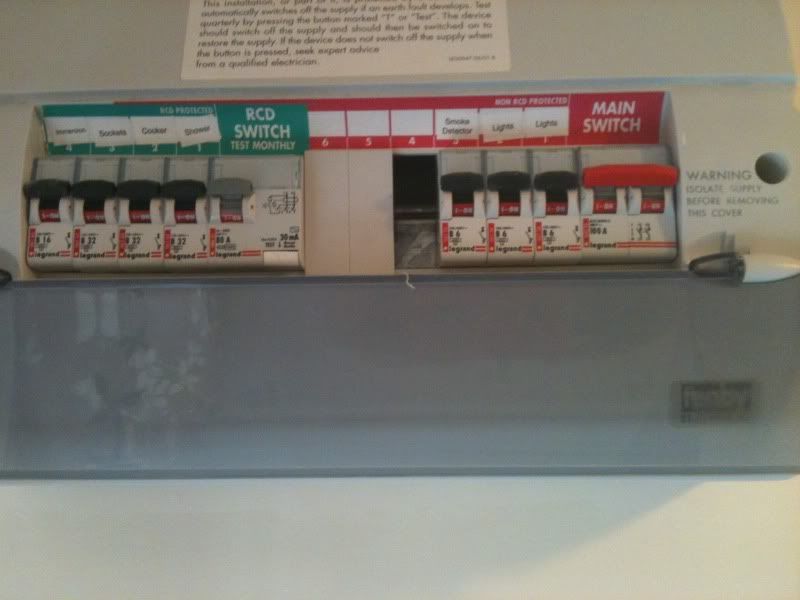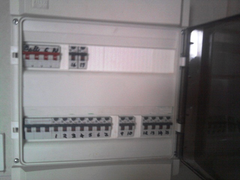Mark G
|
| posted on 8/5/10 at 01:39 PM |

|
|
Anyone know house electrics?
Hi all
I fitted a heated towel rail a few months ago, plumbed it into the radiators and also fitted an electrical heating element. When I fitted it the
electric heater worked fine.
I went to switch on the electric heater last week for the first time since fitting (usually just runs off the central heating) and the main trip for
the house tripped. I thought it was just one of those thing so I reset the trip and tried again. It tripped again...
I just removed the socket (electrics switched off) and measured the resistance of the heater element, only I have nothing to check it against. Does
anyone know if the figures below are about right or do they suggest a short circuit?
N - L = 158 Ohms
N - Earth = 0.750 mOhms
L - Earth = 0.330 mOhms
Thanks
Mark.
[Edited on 8/5/10 by Mark G]
[Edited on 8/5/10 by Mark G]
|
|
|
|
|
ReMan
|
| posted on 8/5/10 at 01:53 PM |

|
|
They look OK to me, not wrong enough to pop a trip anyway.
Is it an MCB on one circuit or the whole lot that is tripping?
I presume the heater is 3-500W ish?
|
|
|
YQUSTA
|
| posted on 8/5/10 at 02:04 PM |

|
|
The problem with elements is as they heat up they can cause a fault then when they cool down the fault can disapear.
"If in doubt flat out"
Colin McRae
|
|
|
NigeEss
|
| posted on 8/5/10 at 02:19 PM |

|
|
On the basis that it's tripping the CB then isn't it safe to assume it goosed regardless
of the resistance reading ?
Time is an illusion. Lunchtime doubly so.................Douglas Adams.
|
|
|
Mark G
|
| posted on 8/5/10 at 02:21 PM |

|
|
The trip is the one labeled as RCD Switch.

The trip blows as soon as you operate the switch and the element is 400w
|
|
|
ReMan
|
| posted on 8/5/10 at 02:32 PM |

|
|
quote:
Originally posted by NigeEss
On the basis that it's tripping the CB then isn't it safe to assume it goosed regardless
of the resistance reading ?
It may well be, but it could also be the wiring or connections to it, rather than the unit itself
As mentioned it may be an internal fault that presents when heating, but the cold readins look good to me.
I presume you have tested for tripping now with the unit disconnected?
|
|
|
t16turbotone
|
| posted on 8/5/10 at 03:06 PM |

|
|
NO....you should only have resistance reading between L-N, you should have no reading to earth....element knackered!!
|
|
|
britishtrident
|
| posted on 8/5/10 at 03:42 PM |

|
|
We had a similar problem to this with the oven when we moved in. It turned out the neutral had been wired to the wrong neutral connection at the
distribution box.
If you look inside the box you will see two neutral connection bars one on the RCD protected side of the box and on the other side just a straight
neutral connection.
I would think your central heating pump is not wired through the RCD but the live supply for the manual switch is wired through the RCD. When you
use the manual switch the the RCD see an imbalance between neutral and live and trips. If you use a double pole isolator switch you should get round
it but if it were mine I would want the rail protected by its own RCD.
[Edited on 8/5/10 by britishtrident]
|
|
|
JoelP
|
| posted on 8/5/10 at 03:42 PM |

|
|
but 0.33megs should put less than 1mA to earth, not 30. Still, that is probably whats wrong with it.
|
|
|
Hector.Brocklebank
|
| posted on 8/5/10 at 04:50 PM |

|
|
i can olny agree with British trident on this check the neutral wiring, i found this out when i fitted my RCBO's, i had two lines (non twin/earth
cable but seperate lines) running in conduit i inadvertantly crossed the neutrals and got a trip , took me ages to fathom out what was up
And after looking at your distribution board, i think i went a teensy little bit overboard with my setup for a three bedroom house. 
 
distribution board
|
|
|
ReMan
|
| posted on 8/5/10 at 05:17 PM |

|
|
quote:
Originally posted by JoelP
but 0.33megs should put less than 1mA to earth, not 30. Still, that is probably whats wrong with it.
My thinking and experiece with dvm's
|
|
|
daniel mason
|
| posted on 8/5/10 at 05:41 PM |

|
|
rcd will trip n-e
your resistance across the element l-n will indicate if element is ok!
|
|
|
paulf
|
| posted on 8/5/10 at 09:40 PM |

|
|
The trouble with checking it with a DVM is the test voltage is to low.If checked with a megger with a 250v test voltage the resistance would be much
lower.
Ive seen it on lots of occasions when people have tested something with a DVM and said its ok but when properly tested with a high voltage megger it
is a dead short.
It sounds like its the element but double check the wiring for stray stands, cuts in insulation etc.
Paul
quote:
Originally posted by ReMan
quote:
Originally posted by JoelP
but 0.33megs should put less than 1mA to earth, not 30. Still, that is probably whats wrong with it.
My thinking and experiece with dvm's
|
|
|
Liam
|
| posted on 8/5/10 at 11:49 PM |

|
|
Did you not even test it when it was fitted? If it ever worked it can't be wired up wrong in the consumer unit so will be a faulty element. If
you have no idea if it ever worked in the first place it could be either. If you can't get access to a proper insulation resistance tester (eg
megger) to properly test the element, you could try connecting a known working appliance to where the towel rail connects. If it works the circuit
wiring is ok so the element is faulty. If the known working appliance still causes the RCD to trip, then it's the wiring. Be careful playing
with electrics in a bathroom.
|
|
|
MikeRJ
|
| posted on 9/5/10 at 06:23 AM |

|
|
quote:
Originally posted by ReMan
quote:
Originally posted by JoelP
but 0.33megs should put less than 1mA to earth, not 30. Still, that is probably whats wrong with it.
My thinking and experiece with dvm's
I read the OP's post and saw 0.33 milliohms...
|
|
|
JoelP
|
| posted on 9/5/10 at 08:12 AM |

|
|
quote:
Originally posted by MikeRJ
quote:
Originally posted by ReMan
quote:
Originally posted by JoelP
but 0.33megs should put less than 1mA to earth, not 30. Still, that is probably whats wrong with it.
My thinking and experiece with dvm's
I read the OP's post and saw 0.33 milliohms...
can OP clarify, milli or mega?! I suppose milli is quite likely since its a DIY tool not a proper insulation tester.
|
|
|
ReMan
|
| posted on 9/5/10 at 10:48 AM |

|
|
Doesnt need to...
If it was milliohms, not that your average dvm would read thsat accuratly
N - Earth = 0.750 mOhms
L - Earth = 0.330 mOhms
Then L-N would be less than 1 Ohm
|
|
|
JoelP
|
| posted on 9/5/10 at 07:17 PM |

|
|
quote:
Originally posted by ReMan
Doesnt need to...
If it was milliohms, not that your average dvm would read thsat accuratly
N - Earth = 0.750 mOhms
L - Earth = 0.330 mOhms
Then L-N would be less than 1 Ohm
resorting to mathematics is just not on  but you do have a very good point! but you do have a very good point!
|
|
|
ReMan
|
| posted on 9/5/10 at 09:12 PM |

|
|

Bored now.
Just buy a new one and see what happens!
  
|
|
|
Mark G
|
| posted on 10/5/10 at 09:11 PM |

|
|
Hi guys, thanks for the replies.
The Meter reads mega ohms, not milli.
Also the heater did work when I checked it when I first installed it. I guess I was just hoping it might be something simple as to replace it I have
to drain the radiators again, take the radiator off the wall again just to take the element out. Also, Its only a few months old and has been used
less than 10 times. I don't know where the reciept is either so I'll have to buy a new one rather than claim warranty.
Sucks really but I guess it has to be done...
|
|
|













